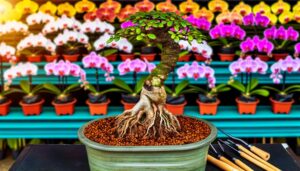How You Can Keep Pine Bonsai Indoors – A Step-by-Step Guide
Keeping pine bonsai indoors is doable but demands expert attention to specific environmental parameters. They require 6-8 hours of direct sunlight daily and should be placed near south-facing windows or under full-spectrum grow lights.
Best humidity levels must be maintained between 40-60%, along with consistent temperatures ranging from 65-75°F. Ensuring proper air circulation and using a well-draining soil mix of akadama, pumice, and lava rock is essential to prevent root diseases and promote robust growth.
Regular watering practices and avoiding sudden temperature changes are also vital. Discover the intricate details necessary for maintaining indoor pine bonsai health.

Key Takeaways
- Yes, pine bonsai can be kept indoors with proper care and environment.
- Ensure 6-8 hours of direct sunlight daily using grow lights if necessary.
- Maintain humidity levels between 40-60% to prevent desiccation.
- Use a well-draining soil mix of akadama, pumice, and lava rock.
- Regulate temperatures between 60-75°F and ensure good airflow to avoid fungal infections.
Understanding Pine Bonsai Needs

Understanding the specific environmental and physiological needs of pine bonsai is essential for safeguarding their health and longevity when kept indoors. Pine bonsai require a balance of light, humidity, temperature, and airflow.
Adequate light is vital; they thrive best under full-spectrum grow lights that mimic natural sunlight. Humidity levels should be maintained between 40-60%, using humidifiers if necessary. Temperature regulation is also crucial, keeping daytime temperatures around 65-75°F and slightly cooler nighttime temperatures.
Additionally, proper airflow prevents fungal infections and promotes gas exchange. Soil composition is another pivotal factor; a well-draining substrate composed of akadama, pumice, and lava rock ensures optimal root aeration and moisture control. Regular monitoring of these conditions is crucial for maintaining a healthy pine bonsai indoors.
Common Indoor Care Challenges
Despite meticulous attention to environmental factors, maintaining pine bonsai indoors presents several challenges that can impede their growth and health. One primary obstacle is inadequate humidity levels. Pine bonsai require a consistent humidity range to thrive, but indoor environments often lack the necessary moisture, leading to desiccation of needles and impaired photosynthesis.
In addition, insufficient air circulation can foster fungal diseases and infestations of pests such as aphids and spider mites. The limited root space in bonsai containers exacerbates nutrient deficiencies, necessitating precise fertilization schedules. Moreover, the indoor atmosphere can suppress natural dormancy cycles, disrupting the physiological processes essential for the bonsai's annual growth patterns.
Addressing these challenges requires a holistic approach to indoor pine bonsai care.
Light and Temperature Requirements
Proper light and temperature regulation are essential for the health and well-being of indoor pine bonsai. Pine species require substantial light exposure, ideally 6-8 hours of direct sunlight daily. Insufficient light can lead to etiolation, characterized by elongated, weak growth. Position them near south-facing windows or utilize full-spectrum grow lights to simulate natural sunlight.
Temperature stability is equally critical; maintain ambient temperatures between 60-75°F (15-24°C). Sudden temperature fluctuations can cause stress, leading to needle drop and other physiological issues. Additionally, avoid placing your bonsai near heating vents or drafty windows, as these can create microclimates that are detrimental to its health.
Consistent monitoring and adjustment are paramount to fostering a thriving indoor pine bonsai.
Watering and Humidity Tips
Maintaining ideal watering practices and humidity levels is crucial for the health of indoor pine bonsai. Proper hydration and consistent moisture levels are vital to prevent desiccation and promote vigorous growth. Here are key guidelines to achieve best conditions:
- Watering Frequency: Water when the topsoil feels slightly dry to the touch, avoiding both waterlogging and prolonged dryness.
- Water Quality: Use soft water or rainwater to prevent mineral buildup, which can harm the roots.
- Humidity Maintenance: Maintain ambient humidity between 40-60% using a humidity tray or a room humidifier.
- Drainage: Ensure pots have ample drainage holes to prevent root rot.
- Misting: Regularly mist the foliage to mimic natural dew and enhance the microclimate.
Adhering to these principles will support a thriving indoor pine bonsai.
Selecting the Right Soil

Choosing the appropriate soil composition is essential for the best growth and health of indoor pine bonsai. Best soil mix should provide excellent drainage and aeration, as pine roots are prone to root rot in waterlogged conditions.
A well-balanced bonsai soil typically includes akadama, pumice, and lava rock in equal parts, ensuring adequate moisture retention while preventing compaction. Incorporating organic components like peat moss or pine bark can enhance nutrient availability, though they should be used sparingly to avoid excess moisture retention.
Regularly monitoring pH levels is crucial, as pine bonsai generally thrive in slightly acidic to neutral soil (pH 5.5 to 6.5). This detailed approach to soil selection fosters robust root development and overall plant vitality.
Conclusion
The viability of maintaining a pine bonsai indoors hinges on comprehending the plant's specific needs and mitigating common indoor care challenges.
Adequate light, temperature regulation, precise watering practices, and appropriate humidity levels are paramount.
Soil selection also plays a critical role in ensuring best growth.
Empirical evidence suggests that while challenging, it is feasible to cultivate a healthy pine bonsai indoors, provided meticulous attention is given to replicating its natural habitat conditions.






